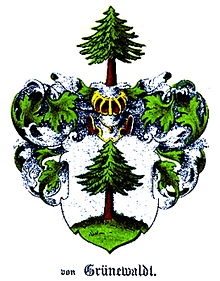Johann Engelbrecht Christoph von Grünewaldt

Johann Engelbrecht Christoph von Grünewaldt ( Russian : Иван Егорович Грюневальдт; born March 21, 1796 in Koik , Estonia ; † April 18, 1862 in Saint Petersburg ) was the Russian civil governor of Estonia and knight captain of the Estonian knighthood .
Life
After the first home tuition , Johann attended the knight and cathedral school in Reval . His study of law , he graduated from the Imperial University of Tartu (1813-1815), and the Universities of Berlin (1815-1816), in Göttingen and Heidelberg (1816-1817). In 1816 he was listed in the Kösener Corps lists in 1910 as a member of Curonia V in Göttingen. In 1816 he, who also composed, appeared in Rome as a singer in an "Estonia Quartet". From 1817 his study trips took him to France , England , Switzerland and Italy . From 1818 to 1820 he lived on his parents' farm in Koik and from 1821 to 1826 took over the lease of the manor in Orrisaar . From 1826 he was the master of Hukas, with Koik and lived there until 1842. In 1821 he became an assessor at the Manngericht and from 1824 to 1827 he was a district deputy . In 1832 he was a member of the commission for the equality of farmers' ordinance. He was elected Knighthood Captain of the Estonian Knighthood in 1830 and held this office until 1836. From 1833 to 1841 he was district administrator in Estonia and in 1835 became a member of the consortium for the establishment of an elementary school teacher seminar . From 1842 to 1859 he was the civil governor of Estonia and in this role he campaigned for peasant schools and promoted cultural endeavors. In 1854 he was awarded the Russian Order of St. Vladimir (2nd class). From 1859 he was Senator , Privy Councilor and President until 1862 and then honorary member of the Estonian Literature Society .
Origin and family
Johann von Grünewaldt came from the German-Baltic noble family von Grünewaldt . His father was the Russian major and Estonian district administrator Johann Adam von Grünewaldt (1763-1817), he was the master of Koik, Affel and Orrisaar. His mother was Anna Christina, born von Kursell (1760–1842). His brother was Otto Magnus von Grünewaldt (1801–1890). In 1821 Johann v. G. Alexandra von Engelhardt (1801–1874), her descendants were:
- Marie von Grünewaldt (1822–1842)
- Julie von Grünewaldt (1823–1900) ⚭ Wilhelm von Samson Himelstjerna zu Thula (1819–1901)
- Konrad von Grünewaldt (1825–1868) ⚭ Natalie von der Pahlen (1831–1906)
- Konstantina von Grünewaldt (1827–1905) ⚭ Karl von Mühlendahl (1811–1891)
- Otto von Grünewaldt (1829–1831)
- Walter von Grünewaldt (1831–1834)
- Katharina von Grünewaldt (1833–1900) ⚭ Friedrich von Gernet zu Sellenküll (1824–1909)
- Georg von Grünewaldt (1835–1836)
- Anna von Grünewaldt (* 1837) ⚭ Gottwalt von zur Mühlen (1825–1907)
- Ernst von Grünewaldt (1839–1891) ⚭ Pauline von Stenbock (* 1846)
literature
- Georges Wrangell: Genealogy of the family von Grünewaldt . Reval 1913 ( digital copy [PDF; 33 MByte] at the University of Tartu , hdl: 10062/25989 ).
- Gruenewaldt . In: Genealogical Handbook of the Baltic Knighthoods: Part of Estonia . tape II . Publishing house for kin research and heraldry CU Starke, Görlitz 1930, p. 45–57 ( digitized at the Munich digitization center ).
- Helmut Scheunchen : Lexicon of German Baltic Music. Harro von Hirschheydt publishing house, Wedemark-Elze 2002. ISBN 3-7777-0730-9 . P. 96.
Web links
- Baltic Historical Commission (ed.): Entry on Johann von Grünewaldt. In: BBLD - Baltic Biographical Lexicon digital
Individual evidence
- ^ Helmut Scheunchen : Lexicon of German Baltic Music. Harro von Hirschheydt publishing house, Wedemark-Elze 2002. ISBN 3-7777-0730-9 . P. 96.
- ↑ et: Huuksi
- ↑ “In 1804, a peasant ordinance was issued in Livonia, through which serfdom ... became subservience to the estate. When Estonia's knighthood then preceded the complete abolition of serfdom in 1816, Courland in 1817 and Livonia in 1818 followed this example. "In: A. von Engelhardt, Die Deutschen Ostseeprovinzen Russlands , Verlag BoD - Books on Demand , 2012, page 46 [1] , accessed on August 20, 2018
- ↑ Russian governors of Estonia (1808-1917), In: Revaler / talliner-representatives from Karsten Brüggemann, Ralph Tuchtenhagen: Tallinn. Little history of the city . IS BN 978-3-412-20601-7, 2011 Böhlau Verlag GmbH & Cie, Cologne Weimar Vienna, page panel VII, [2] , accessed August 17, 2018
- ↑ “On June 10, 1842, which was later regarded as the founding date of the society, the 37 founders met in the apartment of the civil governor Johann Engelbrecht Christoph von Grünewaldt (1796-1862) in the castle on Domberg, elected the leading functionaries and formed six Sections of the Society: for (1) Patriotic Studies, (2) Law, (3) Pedagogy, (4) Linguistics and Philology, (5) Literature, Poetry and Art, (6) Mathematics, Natural History and Medicine. On June 24th the society was officially opened in the palace hall on the Domberg ”. In: Indrek Jürgo: The Estonian Literary Society (1842-1918) . In: Jörg Hackmann (Ed.): Club culture and civil society in Northern Europe . Böhlau-Verlag , 2012. pp. 129–178. ( Digitized version ), accessed August 19, 2018
| personal data | |
|---|---|
| SURNAME | Grünewaldt, Johann Engelbrecht Christoph von |
| ALTERNATIVE NAMES | Grünewaldt, Johann von; Grünewaldt, Ivan |
| BRIEF DESCRIPTION | Estonian politician and Russian civil governor |
| DATE OF BIRTH | March 21, 1796 |
| PLACE OF BIRTH | Koik |
| DATE OF DEATH | April 18, 1862 |
| Place of death | St. Petersburg |